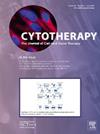通过靶向 GATA6 介导的途径促进间充质干细胞/基质细胞的免疫调节功能。
IF 3.7
3区 医学
Q2 BIOTECHNOLOGY & APPLIED MICROBIOLOGY
引用次数: 0
摘要
背景目的:间充质干/基质细胞(MSCs)的免疫调节能力是使其在再生医学中具有特殊价值的关键特征。然而,这种潜力会受到供体的时间老化和培养过程中细胞扩增程序的影响。我们已经证明,GATA 结合蛋白 6(GATA6)在间充质干细胞的衰老过程中起着关键作用,抑制 GATA6 可使间充质干细胞重新焕发活力:在这项研究中,我们分别使用诱导多能干细胞衍生的再生间充质干细胞(rMSCs)及其亲本间充质干细胞(pMSCs),比较了年轻和年老间充质干细胞模型的免疫调节能力,以确定参与这些能力的不同调控的关键机制。此外,我们还探讨了 GATA6 在介导该机制中的作用:结果:我们的研究结果表明,与 pMSCs 相比,rMSCs 表现出下调衰老相关调控因子,包括 p53、p21 和 GATA6,并显示出更强的 T 细胞增殖抑制能力。通过分析之前的RNA-seq数据和采用靶基因敲除,我们确定细胞因子信号转导抑制因子3(SOCS3)和白细胞介素6都参与了GATA6诱导的调控,共同影响了程序性死亡配体1(PDL1)在pMSCs和rMSCs中的表达:我们的研究结果强调了GATA6/SOCS3/PDL1通路在调节间充质干细胞免疫调节活性衰老相关变化中的重要性,为rMSCs在治疗免疫性疾病和再生医学中的潜在应用提供了有价值的见解。本文章由计算机程序翻译,如有差异,请以英文原文为准。
Advancing immunomodulatory functions in mesenchymal stem/stromal cells through targeting the GATA6-mediated pathway
Background aims
The immunomodulatory capacity of mesenchymal stem/stromal cells (MSCs) is a key feature that makes them particularly valuable for regenerative medicine. However, this potential is affected by the chronological aging of the donors and the cell expansion procedures in culture. We have demonstrated that GATA binding protein 6 (GATA6) plays a pivotal role in the aging of MSCs and inhibiting GATA6 rejuvenates the characteristics of MSCs.
Methods
In this study, we compared the immunomodulatory capabilities of young and old MSC models, using induced pluripotent stem cells-derived rejuvenated MSCs (rMSCs) and their parental MSCs (pMSCs), respectively, to identify a key mechanism involved in the differential regulation of these capabilities. Additionally, we explored the role of GATA6 in mediating the mechanism.
Results
Our results demonstrated that rMSCs exhibited downregulated aging-associated regulators, including p53, p21 and GATA6, and showed enhanced suppression of T cell proliferation compared to pMSCs. Through analyzing our previous RNA-seq data and employing target gene knockdown, we determined both suppressors of cytokine signaling 3 (SOCS3) and interleukin 6 were involved in GATA6-induced regulation, collectively affecting the expression of programmed death ligand 1 (PDL1) in both pMSCs and rMSCs.
Conclusions
Our findings underline the significance of the GATA6/SOCS3/PDL1 pathway in regulating aging-associated changes in MSC immunomodulatory activity, providing valuable insights into the potential use of rMSCs in the treatment of immune diseases and regenerative medicine.
求助全文
通过发布文献求助,成功后即可免费获取论文全文。
去求助
来源期刊

Cytotherapy
医学-生物工程与应用微生物
CiteScore
6.30
自引率
4.40%
发文量
683
审稿时长
49 days
期刊介绍:
The journal brings readers the latest developments in the fast moving field of cellular therapy in man. This includes cell therapy for cancer, immune disorders, inherited diseases, tissue repair and regenerative medicine. The journal covers the science, translational development and treatment with variety of cell types including hematopoietic stem cells, immune cells (dendritic cells, NK, cells, T cells, antigen presenting cells) mesenchymal stromal cells, adipose cells, nerve, muscle, vascular and endothelial cells, and induced pluripotential stem cells. We also welcome manuscripts on subcellular derivatives such as exosomes. A specific focus is on translational research that brings cell therapy to the clinic. Cytotherapy publishes original papers, reviews, position papers editorials, commentaries and letters to the editor. We welcome "Protocols in Cytotherapy" bringing standard operating procedure for production specific cell types for clinical use within the reach of the readership.
 求助内容:
求助内容: 应助结果提醒方式:
应助结果提醒方式:


